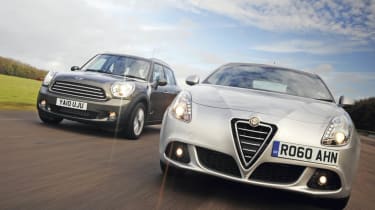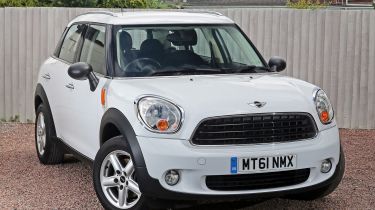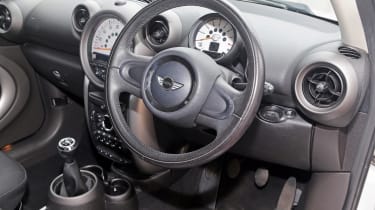Used MINI Countryman (Mk1, 2010-2017) review
The MINI Countryman Mk1 is an eye-catching, fun-to-drive and handily versatile small SUV, if not exactly the most practical option out there
Verdict
MINI had never made an SUV before it launched the first-gen Countryman, and its first attempt was by-and-large pretty good. Perhaps unsurprisingly, it was far roomier inside than any MINI that had come before, and the characteristic fun-to-drive handling of the regular hatchback had been retained for the most part on the larger Countryman, too. Running costs are kept down by the good fuel economy, but bear in mind the car’s more upmarket image and strong residual values means you’ll pay a premium over an alternative from a more mainstream marque to have a used MINI Countryman Mk1 on your driveway.
Which one should I buy?
- Best MINI Countryman Mk1 for families: Countryman Cooper SD
- Best MINI Countryman Mk1 for economy: Countryman One D
- Best MINI Countryman Mk1 for performance: Countryman John Cooper Works ALL4
The MINI Countryman Mk1 joined the MINI range in September 2010, and was available with a broad array of options for buyers to sink their teeth into. As well as the myriad optional extras and cosmetic additions that are par for the course for MINI cars, the Countryman also came with a variety of petrol and diesel engine options. However, prospective Countryman Mk1 owners would have to wait until March 2011 for an all-wheel-drive option to arrive and start filtering its way through the Countryman line-up.
Used - available now

2020 Mini
Countryman
45,323 milesManualPetrol1.5L
Cash £16,400
2018 Mini
Countryman
35,879 milesAutomaticPetrol2.0L
Cash £18,000
2018 Mini
Countryman
42,704 milesAutomaticPetrol1.5L
Cash £15,600
2022 Mini
Countryman
11,057 milesAutomaticPetrol1.5L
Cash £21,706In the following years, updates were fairly minimal on the MINI Countryman Mk1. September 2012 saw the last major addition to the engine range introduced, in the form of the 215bhp turbo-petrol engine in the range-topping John Cooper Works performance model. There was also a light facelift in 2013, which brought about some small quality-of-life improvements such as the relocation of the electric window switches from the centre console onto the doors.
Another facelift was introduced in 2014, which was a bit more comprehensive: new dark grey instrument dials were added across the range, and the exterior bodywork was given a bit of a redesign such as subtle chrome detailing on the front air intakes. The engines were made a little bit more efficient, too, which in conjunction with the mildly more aerodynamic bodywork meant the Countryman Mk1 was a little bit more efficient in its post-2014 update phase. By January 2017, the MINI Countryman Mk1 had been removed from sale and replaced with a second-generation version of the SUV.
By and large, none of the engine options on the MINI Countryman Mk1 are bad, so the end choice is really down to whether you’d prefer petrol or diesel and how much of a turn of speed you’d want. As general all-rounders, though, the Cooper petrol and the Cooper D and Cooper SD diesels are good to consider as they offer nicely judged blends of fuel economy and performance.
Even the entry-level One models come with a decent amount of equipment as standard, so they’re worth having on your mind when shopping around. However, regardless of your preferred trim level, there’s no harm in having a closer look at the specifications on the used listings: because lots of optional extras were offered on the MINI Countryman Mk1 when it was new, the spec levels can vary quite a bit from car to car.
What are the alternatives?
The MINI Countryman Mk1 dates back to a time when small SUVs were quickly becoming popular with car buyers, so there are a number of alternatives to choose from. If you’re looking for options to the Countryman that are on par with the MINI when it comes to distinctive styling, then it’s worth having the Nissan Juke and the Fiat 500X on your radar.
In contrast, cars such as the Peugeot 2008 and Renault Captur aren’t quite as striking to look at, although they are still smartly styled. Should value for money be a main priority for you, then there are also the Ford EcoSport and Vauxhall Mokka to consider: they’re not as stylish as the MINI or as well-rounded, but they’re generally more affordable to buy than a like-for-like Countryman Mk1, and there are plenty to pick from on the used market.
If you’re willing to look at slightly larger options, then bigger-but-still-compact family SUVs like the Skoda Yeti are worthy candidates if you’re considering a used small crossover as your next car.
Officially, the MINI Countryman Mk1 was only ever sold as a five-door car. However, buyers who would prefer something a bit more distinctive do have at their disposal the MINI Paceman, which was in essence a Countryman Mk1 but with tweaked styling and a different three-door bodystyle
MINI Countryman vs Alfa Romeo Giulietta

For this family car head-to-head from November 2010, the MINI Countryman went up against a more conventional hatchback alternative, in the form of the Alfa Romeo Giulietta. While the Alfa Romeo had the edge when it came to price and performance, the MINI Countryman was more characterful and fun to drive, and also had lower running costs. As a result, the MINI was the victor of this test. Read the full test...
MINI Countryman vs Nissan Juke
In a world exclusive, we pitted the MINI Countryman against the then-new Nissan Juke in our SUV twin test from July 2010. Overall, we reckoned the MINI was not only the more practical car, but was also nicer to drive and came with a higher-quality interior than the Nissan. However, those advantages were perhaps expected, considering the MINI Countryman was £5,115 more expensive than the Nissan Juke. Read the full test...
MINI Countryman vs Nissan Juke
In July 2011, the MINI Countryman once again went head-to-head with the Nissan Juke. However, things were a bit different this time around, because this one featured the sportier Juke Turbo and Countryman Cooper S models. Like before, though, it was the MINI Countryman that was crowned the winner: while the Nissan had the edge with the lower price, the Countryman made up for this with its roomier and higher-quality interior, nicer driving dynamics, lower running costs and stronger residual values. Read the full test...








